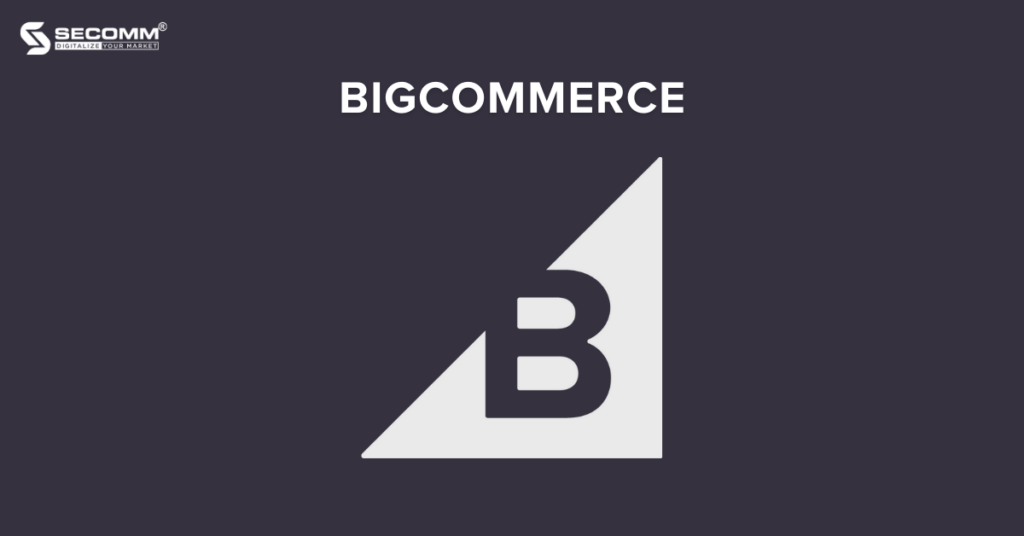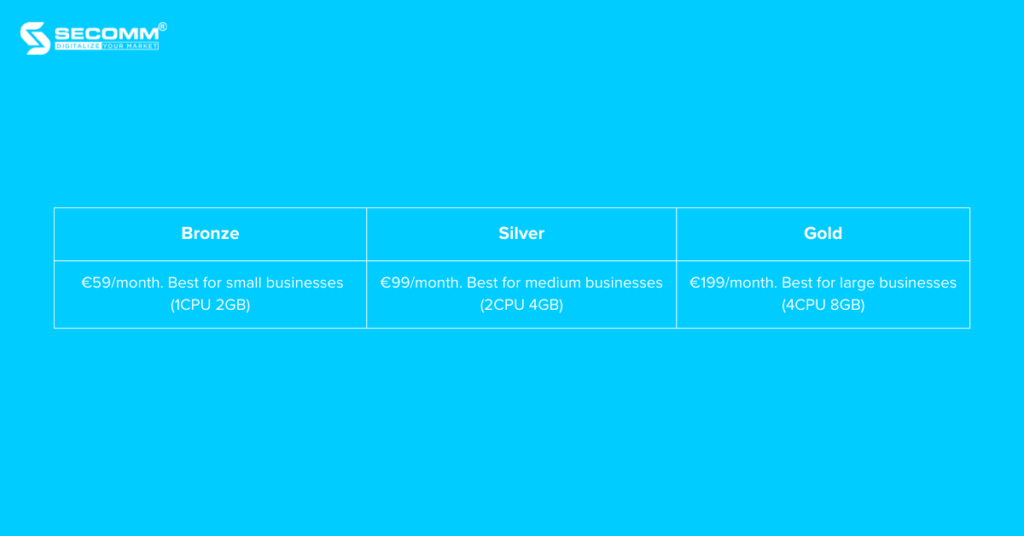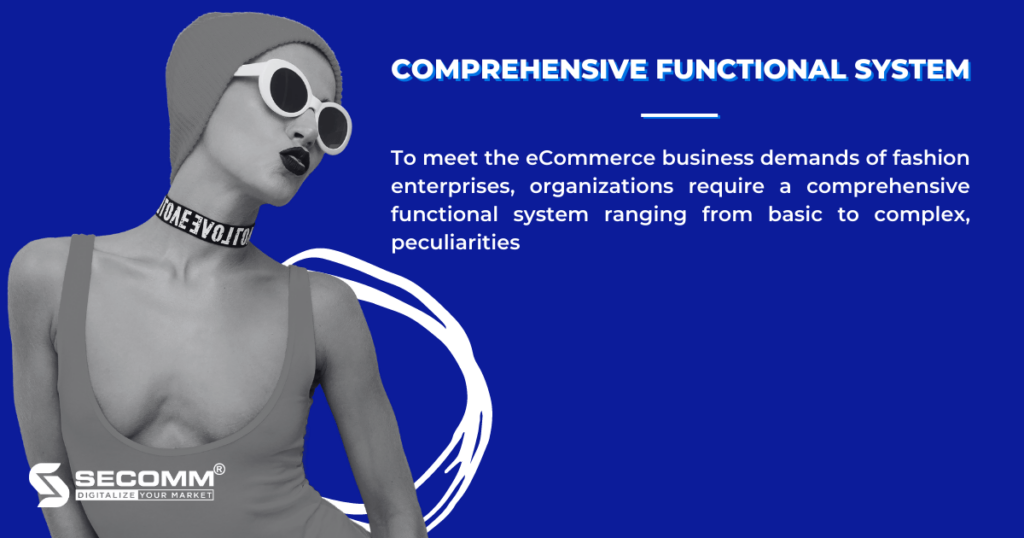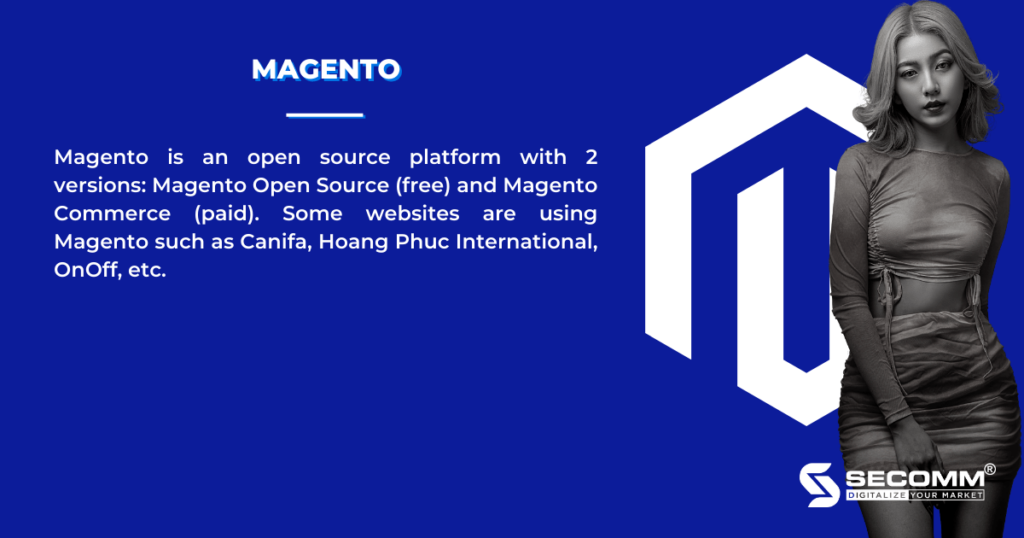It seems we can’t find what you’re looking for. Perhaps searching can help.
Sign Up for newsletter!
Subscribe to get the latest eBook!
Hotline







The Australian eCommerce world is continually evolving alongside the constant emergence of technological solutions. As a result, there is an increasing and diverse range of choices for eCommerce platforms.
This presents both an advantage and a challenge for businesses, as selecting the right platform for building an eCommerce website is a crucial first step.
Below are the top 5 leading eCommerce platforms in Australia.
Learn more: Top 10 most-visited eCommerce websites in Australia
Magento is a globally popular open-source platform, and its prevalence extends to Australia as well. According to BuiltWith, there are currently more than 4000 live websites in Australia utilizing the platform.
With its high flexibility, businesses can effortlessly tailor features and scale the system according to their unique business requirements.
Presently, Magento provides businesses with two versions: Open Source (Free) and Adobe Commerce (Paid).

Pros:
Cons:
Core feature:
Pricing:
Learn more: Top Magento eCommerce websites in Australia
Shopify is a popular SaaS platform with over 4.8 million active websites. In Australia alone, over 150 thousand online stores are operating on the platform.
Recently, the premium version of Shopify, ‘Plus,’ has garnered attention from businesses across various sectors in Australia.
These businesses may have previously deployed different eCommerce platforms and later switched to the Plus to seek a superior solution. Some businesses initially launched websites with core plans and later upgraded to ‘Plus’ to optimize their operations.

Learn more: Top eCommerce websites upgrade to Shopify Plus
Pros:
Cons:
Core feature:
Pricing
Here are Shopify pricing plans:

BigCommerce is another popular SaaS platform worldwide, with over 43 thousand active websites. In Australia, there are more than 2 thousand active BigCommerce websites.
The standout feature of this SaaS platform is its integrated features, enabling businesses of all sizes and technical expertise to deploy eCommerce websites quickly. In addition to standard solution packages, BigCommerce offers an ‘Enterprise’ version tailored for large businesses with custom pricing.
Learn more: Top 10 eCommerce websites using BigCommerce

Pros:
Cons:
Core feature:
Pricing
Here are BigCommerce pricing plans:

WooCommerce, a free and open-source WordPress plugin, enables brands to integrate eCommerce functionality into their existing WordPress websites.
With just a few clicks, the WooCommerce plugin helps convert a standard WordPress site into a fully-featured eCommerce platform, complete with essential features and easy customization.
Learn more: 20 websites using WooCommerce

Pros:
Cons:
Core feature:
Pricing: Free to use. However, some integrations with other plugins may incur charges.
OpenCart is a globally popular open-source platform, powering over 900 thousand active websites worldwide. In Australia, it has gained popularity with more than 2 thousand active OpenCart websites, establishing itself as a favored open-source platform in the country, following Magento.
Founded by Daniel Kerr in 1998, OpenCart operates as open-source software, utilizing the PHP programming language. It currently offers two versions: Free (Free-to-use version) and Cloud Store (Paid version).

Learn more: Top OpenCart websites
Pros:
Cons:
Core feature:
Pricing:
Free for the Free version. For the Cloud Store version, the specific costs are as follows:

Above are 10 eCommerce platforms preferred by businesses in Australia when establishing their online stores. Each business will make its decision based on factors like scale, business model, and specific deployment requirements.
With over 10 years of experience collaborating with various Australian businesses such as Laybyland, RodShop, Trentham Estate, Jasnor, etc., to build eCommerce websites, SECOMM now possesses a team of highly skilled technical experts and a deep understanding of the Australian market.
For personalized advice on the best-suited platforms for your business, contact us or call the hotline (+84)28 7108 9908 today!
 2
2
 4,106
4,106
 0
0
 1
1
Despite the significant impact of Covid-19, the fashion industry is still on a roll, with the potential to reach $1 trillion globally by 2025 (according to Statista) thanks to eCommerce.
According to the IDEA 2022 research, the fashion eCommerce business in Vietnam is a highly competitive area, with up to 69 consumers using the eCommerce channel for every 100 fashion shoppers.
With the high potential of this commerce business, developing an eCommerce website is a must for success, necessitating the search for a platform on which to build a specialised eCommerce website for the fashion industry.
Businesses can use the following platforms to deploy fashion websites: Big Cartel, Haravan, Shopify, Woocommerce, and Magento.
UI/UX is a criterion that businesses frequently establish when creating an eCommerce website in order to develop a comfortable interface for a group of users who are passionate about fashion and maximise the capacity to engage with customers.


To meet the eCommerce business demands of fashion enterprises, organizations require a comprehensive functional system ranging from basic to complex, which includes:
To provide clients with a comprehensive shopping experience, fashion enterprises may frequently combine a number of payment options, shipping services, management software, and business analysis tools to enhance the e-commerce business system.

Numerous common payment options available today must be integrated into the website, including:
Often, firms at the start of a fashion business will not focus on the capacity to develop eCommerce websites in the future since platforms that enable this function are typically scarce. But, in terms of strategy, investing in a platform that supports this function can help organisations gain a competitive advantage over competitors in the market.

Haravan is a well-known SaaS eCommerce platform in the Vietnamese industry, offering a variety of options for both enterprises and individuals. Haravan is used by a variety of websites, including Juno, Biti’s, Maison, and others.

Pro:
Cons:
→ Rating: 2/4
Haravan is suitable for start-up furniture businesses or SMEs (small and medium-sized enterprises) with operations mainly in Vietnam.
Haravan is considered to have a reasonably low and diverse eCommerce website implementation cost for various businesses:
Tuy nhiên, doanh nghiệp nên suy xét khi sử dụng Haravan trong dài hạn vì chi phí giấy phép sử dụng và các tiện ích mở rộng sẽ ngày càng tăng theo thời gian sử dụng.
However, businesses should consider when using Haravan in the long term because the cost of licenses and extensions will increase over time.
Shopify is a SaaS ecommerce platform favored by the international ecommerce business community because of its fast implementation time and reasonable starting cost.

Pro:
Cons:
→ Rating: 2/4
Shopify is considered suitable for start-ups or SMEs with global operations.
Starting an eCommerce business using Shopify is quite inexpensive at beginning, with several options:
Nevertheless, the long-term cost of utilising Shopify will rise owing to rising costs for extensions, yearly usage fees, and % per transaction on the system.
The typical time to develop an e-commerce website is 1-7 days or more, depending on the system’s complexity.
Big Cartel is a platform that assists in the creation of specialised eCommerce websites for the fashion industry or for art goods such as ceramics, paintings, and photographs. Big Cartel is used by several websites such as Atakontu, Indikidual, and others.

Pro:
Cons:
→ Rating: 2.5/4
Big Cartel will be appropriate for startups, SMEs, or new e-commerce participants that need to handle the complicated “issue” of fashion eCommerce.
Website setup expenses are modest, with few possibilities for solution packages such as Haravan or Shopify:
Big Cartel allows you to develop a fashion e-commerce website in as little as 1-2 weeks, depending on the system’s complexity.
WooCommerce is an open source platform, as a WordPress plug-in introduced in 2011 and allows businesses to use completely free. Popular websites using WooCommerce in Vietnam include Hai Trieu, Orchard, etc.

Pro:
Cons:
→ Rating: 3/4
WooCommerce is suitable for fashion businesses who are used to WordPress before and are in need of developing an eCommerce system.
Because it is an open source platform, fashion firms can use it for free; nevertheless, businesses must pay development costs while utilising the platform, such as:
An eCommerce website will take longer to create than the previous three platforms since it must be constructed from the ground up, which will take at least 1-3 months.
Magento is an open source platform with 2 versions: Magento Open Source (free) and Magento Commerce (paid). Some websites are using Magento such as Canifa, Hoang Phuc International, OnOff, etc.

Pro:
Cons:
→ Rating: 4/4
Magento is appropriate for a wide range of fashion business types, including B2B, B2C, and B2B2C, as well as a wide range of business sizes, including startups, SMEs, and huge corporations. Nevertheless, because the cost of deploying Magento is sometimes very high, Magento is favoured by major organisations.
Magento Open Source, like WooCommerce, is an open source platform, therefore it is free to use; nonetheless, businesses must consider the following costs:
Businesses will be working directly with Magento’s development team for Magento Commerce, thus they will have to pay licence fees as well as certain additional charges such as:
A complete Magento project typically requires 3 to 6 months of deployment time, with some projects requiring up to a year. The reason for this is the complicated functioning structure and the lack of Magento experts.

 2
2
 4,518
4,518
 0
0
 1
1Subscribe to get the latest eBook!
Hotline